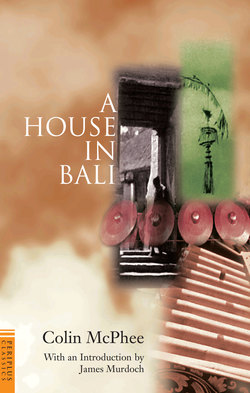Читать книгу House in Bali - Colin McPhee - Страница 7
На сайте Литреса книга снята с продажи.
ОглавлениеILLUSTRATIONS
Between pp. 64-5.
Gateway to Besakih, Mother Temple of Bali.
Temple offerings.
Cakes, fruits and sweetmeats for the gods.
Trompong player.
The deep-toned jégogans carry the bass.
The gangsas fill the air with ringing sound.
In the temple courtyard young girls perform the ceremonial rejang.
The little lélong dancers perform for the pleasure of both gods and mortals.
In the Temple of the Dead the women of Sayan dance before each shrine.
Each afternoon for a week the young girls from twenty villages gathered to dance at a harvest feast in Tabanan.
G’ndérs play the melody for the Wong dance.
The children’s orchestra.
The author’s Gamelan of Semara, the Love God.
Cymbals and little bells add shimmer to the music of Semara the Love God.
The guru, I Lunyuh.
The dalang opens his puppet-box.
We kill a pig for the galungan holiday.
Mask play.
The beloved but terrifying barong.
The witch Chalonarang.
Between pp. 160-1.
The garden at the house in Sayan.
Sampih dances kebyar: the opening.
The dance comes to an end.
Jews’ harps.
Arja musicians.
A feast delicacy—grilled sticks of turtle meat.
Rantun, the cook.
The ancient and holy Selunding gamelan that came out of the sea.
The soft-toned flutes of the ancient gambuh play.
Gedé Manik, drummer, dancer, composer of kebyar.
Sampih.
Lotring, the composer, was also famous for his subtle spicing of feast dishes.
Gusti Lanang Oka, a musician.
Kuta fishermen.
Durus.
Prince and Princess in the gambuh play.
Prince Panji and Perebangsa.
The new Stamboul Club near Den Pasar was encouraged by the Dutch School Supervisor and visiting missionaries, who considered it set a fine example.
North Bali gamelan.
